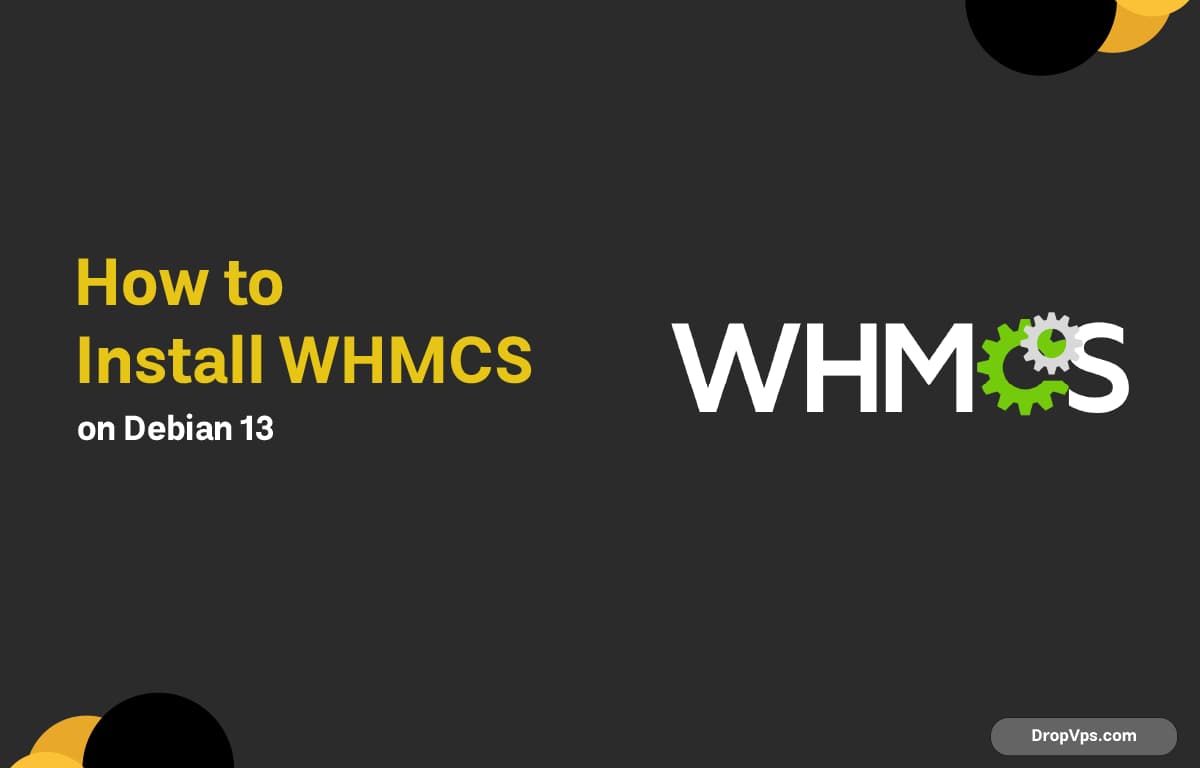DropVPS Team
Writer: Cooper Reagan
How to Install WHMCS on Debian 13

Table of Contents
WHMCS is the most widely used billing and automation platform for hosting companies, VPS providers, and domain resellers. Debian 13 (Trixie) provides a stable, high-performance base for running WHMCS with Apache, PHP, and MariaDB.
Step 1: Update System Packages
Start by updating your Debian 13 server:
sudo apt update && sudo apt upgrade -yStep 2: Install Apache Web Server
WHMCS works best with Apache.
sudo apt install apache2 -y
sudo systemctl enable --now apache2Check service status:
systemctl status apache2Step 3: Install PHP and Required Extensions
WHMCS requires specific PHP modules. Install them all at once:
sudo apt install -y php php-cli php-fpm php-mysql php-curl php-zip php-xml php-json php-mbstring php-gd php-intl php-opcache php-bcmath php-imagickRestart Apache:
sudo systemctl restart apache2Verify PHP version:
php -vStep 4: Install MariaDB Server
WHMCS uses MySQL/MariaDB for data storage:
sudo apt install mariadb-server -y
sudo systemctl enable --now mariadb
sudo mysql_secure_installationStep 5: Create WHMCS Database and User
Log in to MariaDB:
sudo mysql -u rootThen run:
CREATE DATABASE whmcs;
CREATE USER 'whmcsuser'@'localhost' IDENTIFIED BY 'StrongPasswordHere';
GRANT ALL PRIVILEGES ON whmcs.* TO 'whmcsuser'@'localhost';
FLUSH PRIVILEGES;
EXIT;Step 6: Download and Upload WHMCS
WHMCS requires a valid license, so download it from your WHMCS client area.
Upload the ZIP to your server via SFTP or your hosting panel.
Move to your web root:
cd /var/www/Extract:
sudo unzip whmcs.zip -d whmcsSet proper permissions:
sudo chown -R www-data:www-data whmcs
sudo chmod -R 755 whmcsStep 7: Configure Apache Virtual Host
Create a configuration file:
sudo nano /etc/apache2/sites-available/whmcs.confAdd:
<VirtualHost *:80>
ServerName your-domain.com
DocumentRoot /var/www/whmcs
<Directory /var/www/whmcs/>
AllowOverride All
Require all granted
</Directory>
ErrorLog ${APACHE_LOG_DIR}/whmcs-error.log
CustomLog ${APACHE_LOG_DIR}/whmcs-access.log combined
</VirtualHost>Enable site + modules:
sudo a2ensite whmcs.conf
sudo a2enmod rewrite
sudo systemctl restart apache2Step 8: Install IonCube Loader (Required)
WHMCS will not run without IonCube.
Download:
cd /tmp
wget https://downloads.ioncube.com/loader_downloads/ioncube_loaders_lin_x86-64.tar.gz
tar xvf ioncube_loaders_lin_x86-64.tar.gzFind PHP’s extension directory:
php -i | grep extension_dirCopy the correct loader:
sudo cp ioncube/ioncube_loader_lin_8.2.so /usr/lib/php/20230831/Enable it:
echo "zend_extension=/usr/lib/php/20230831/ioncube_loader_lin_8.2.so" | sudo tee /etc/php/8.2/apache2/conf.d/00-ioncube.iniRestart Apache:
sudo systemctl restart apache2Step 9: Run WHMCS Installer
Visit:
http://your-domain.com/installComplete the wizard:
-
Enter database credentials
-
Enter your WHMCS license key
-
Create admin account
After the installation finishes, remove the installer:
sudo rm -rf /var/www/whmcs/installOptional Step: Enable HTTPS with Certbot
To secure WHMCS with SSL:
sudo apt install certbot python3-certbot-apache -y
sudo certbot --apacheThis automatically configures HTTPS. WHMCS stores customer data, invoices, payment logs, and API credentials — set up automated backups for both your WHMCS directory and its database to avoid data loss.